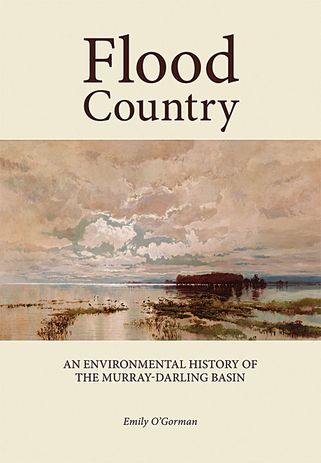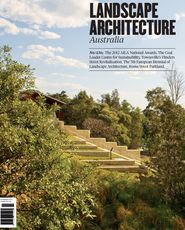
Flood Country – An Environmental History of the Murray-Darling Basin by Emily O’Gorman.
Landscape architects can find themselves reluctantly watering down their design proposals in the face of competing demands from a flotilla of stakeholders. When the boat comes in, the landscape architect’s original intent, which is usually to create a unique place while reaching common ground, can be left high and dry. Similarly, land use within the Murray-Darling Basin has long been inured with the conflicting, frequently opposing interests of irrigators, graziers, residents, and state and federal governments.
This tension flows continually throughout Flood Country, Emily O’Gorman’s environmental history of Australia’s best-known river system. It makes the 2010 bonfire of draft water plans by farmers in the New South Wales town of Griffith seem like a drop in the ocean, considering the previous 160-year environmental management of the Murray-Darling Basin that the book explores. Given the breadth of issues O’Gorman’s research brings together, it is not enough to simply look at the management of the Basin as being a battle between environmentalists advocating increased water flows for ecological improvement and farmers upset over their debt-to-capital ratios, seeing their water allocations evaporate and, as a consequence the banks bleeding them dry. Environmental concerns about river health only entered mainstream debate during the 1990s, and have risen accordingly as the climate change debate has heated up. Such concern is only one part, albeit a significant one, of a large pool of voices wanting to have their say regarding the future of the Basin, which accounts for 40 percent of Australia’s agricultural production.
Flood Country follows a chronological course through European land-use practices in the Murray-Darling catchment, focusing on significant flooding events affecting four townships: Gundagai (1852), Bourke (1890), Mildura (1956) and Cunnamulla (1990). O’Gorman intercedes these events with a chapter examining the consequences for water management for the inhabitants of each country town, compiling from historical documents reactions to the events and the efforts put in place to avoid repeat failures. What becomes evident throughout is the difference between local knowledge and government response, both then and now. Despite warnings from Indigenous members of the community and knowledge of several floods in the decade prior to 1852 (both of which encouraged some settlers to push for the town to be relocated to nearby higher ground), Gundagai was rebuilt in the same spot, due to local vested business interests and political economy. The 1852 disaster still remains Australia’s deadliest flood, with up to one hundred people believed to have drowned. In the ensuing wash-up, the colonial New South Wales Government’s failure to acknowledge that the town was sited on land prone to flooding was guided by warding off its potential liability in compensation claims that had implications, by precedent, throughout the colony. Yet Flood Country reveals that over the course of the next 160 years communication problems between scientists, government response teams and local communities were still occurring, with tragic results. State and federal inquests into emergency responses to the Victorian floods of 2010–11 identified continued ad hoc arrangements between agencies that lead to poor coordination, warning failures and confusion among the riverine communities affected.
Currently a similar gulf separates the interests of stakeholders in the Basin, with water allocation surfacing as the biggest stumbling block in negotiations for resource sharing discussions. The Murray-Darling Basin Authority is finding little consensus between the conflicting agendas and interests of state governments, resource authorities, regional local councils, environmentalists and farmer lobby groups. Farmers and irrigators see the current plan for the Basin as being aligned with the federal Water Act 2007, favouring the environment at the expense of social and economic interests, and being indicative of a federal government top-down decision-making process taking precedence over a bottom-up regional approach that is inclusive of fair and integrative consultation that better acknowledges local knowledge and wishes. O’Gorman’s research supports the farmers’ call for a less Canberra-focused approach to the Basin’s water management, for one that better incorporates the local environmental knowledge of Indigenous people, farmers, and country town inhabitants accustomed to the extremely variable flows occurring there. The implications of climate change, along with mounting evidence indicating many distinct localized hydrological changes within the Basin, further emphasize the need of local knowledge in environmental decision-making processes.
Flood Country meticulously compiles an account of European machinations in the use of water from the Murray-Darling, presenting the historical conundrums confronting its successful management, and exploring how they have shaped the entanglement of issues today. O’Gorman’s book, with a litany of disputes tabled since the mid-nineteenth century, clearly documents the complexity that stymies a solution to the Basin’s water management. Still in its third draft, the intensely troubled Murray-Darling Basin Plan continues to take on water, slowly sinking under the weight of its dissolute attempts at appeasing the often conflicting demands of each disparate stakeholder. For instance, the Victorian and South Australian governments appear irrevocably opposed over the amount of water that should be returned to the environment.
Landscape architects who wade into large environmental projects may do well to reflect on the complex issues saturating Flood Country. While local community involvement is necessary in formulating and implementing management objectives, the task of adequately addressing the interests of everyone further downstream may be akin to attempting to raise the Titanic.
Emily O’Gorman, CSIRO Publishing, 2012, paperback, 280 pages. RRP $49.95
Source

Discussion
Published online: 1 Nov 2012
Words:
Julian Bull
Issue
Landscape Architecture Australia, November 2012














